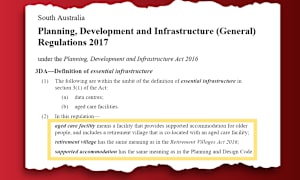Why has Keyton for the second year financed a Future of Retirement Living roundtable in Canberra plus a full page in the Australian?
They identify two major problems: bureaucrats still don’t understand what retirement villages are and don’t understand that they are part of the housing and ageing solution.
A Keyton representative told us their strategy behind this considerable dollar investment is to:
“not only demonstrate the value of retirement living to the wider community, but also to reach those critical decision makers who can help our sector grow.”
Keyton, our largest retirement village operator and now 50% owned by Aware Super, has a similar problem to other village operators – it is increasingly hard to get approvals to build new villages. Despite its size and financial backing, it has very little new village development it can point to in the last five years.
This week, a CEO pointed out to us that their local mayor still did not understand that retirement villages are not aged care homes, despite there being 10 villages within 15km of the town centre. Incredible but true.
Surely it is time for the sector to join Keyton to educate the true village story?
Villages are a proven wellbeing model
Retirement villages offer a proven lifestyle choice for 220,000 senior Australians who know what they want. It is a sector backed by more than 75 years of success.
Villages are purpose-built and affordable housing, averaging around $650,000.
Villages provide secure, age-friendly homes with community facilities, professional support, and peace of mind through to later life.
Our own research from 2020 indicated 43% or residents have improved mental wellbeing, 40% improved financial security, and 28% improved physical health.
One of the main talking points of the Retirement Living Council is that residents are 20% less likely to require hospitalisation after only nine months’ being in retirement living, which leads to 14,000 avoided annual hospitalisations across Australia.
Every retirement village unit purchased releases a family home for a young family.
It’s in the corridors of bureaucrats and decision-makers who sit in air-conditioned offices that the sector needs to cut through.
Instead, residential developers receive incentives for building smaller homes for families while village developers include an additional 30% in build costs to deliver the facilities enjoyed by residents to support their quality of life.
Keyton’s spend on The Australian will reach 4.801 million people (printed newspaper and its digital platforms). It is a start but more is needed if we are to successfully educate the public (and bureaucrats) on the unique community asset retirement villages are.











